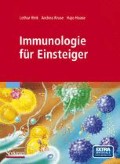Zusammenfassung
Zellen des angeborenen Immunsystems, beispielsweise die Makrophagen, verfügen über eine Reihe von Rezeptoren, die es ihnen ermöglichen, Pathogene anhand hoch konservierter molekularer Muster direkt zu binden. T-Zellen erkennen keine freien Antigene, sie werden nur dann aktiviert, wenn antigenpräsentierende Zellen (APC, antigen-presenting cells) die Peptidfragmente, an bestimmte Oberflächenproteine gebunden, dem T-Zell-Rezeptor präsentieren. Der T-Zell-Rezeptor (TCR, T cell receptor) wird bereits während der Reifung der T-Zellen im Thymus (Kap. 2) danach ausgewählt, ob er mit den antigenpräsentierenden Molekülen des Organismus zu interagieren vermag.
Access this chapter
Tax calculation will be finalised at checkout
Purchases are for personal use only
Preview
Unable to display preview. Download preview PDF.
Literatur
Barral DC, Brenner MB (2007) CD1 antigen presentation: how it works. Nat Rev Immunol 7: 929–941
Guermonprez P, Valladeau J, Zitvogel L, Théry C, Amigorena S (2002) Antigen presentation and T cell stimulation by dendritic cells. Annu Rev Immunol 20: 621–667
Kumanovics A, Takada T, Fischer Lindahl K (2003) Genomic Organization of the Mammalian MHC. Annu Rev Immunol 21: 629–657
Kurts C, Robinson BWS, Knolle PA (2010) Cross-Priming in Health and Disease. Nat Rev Immunol 10: 403–414
Trombetta ES, Mellman I (2005) Cell biology of antigen processing in vitro and in vivo. Annu Rev Immunol 23: 975–1028
Abbildungen
Abbildung 4.1: RCSB Protein Data Bank (http://www.pdb. org) PDB-ID 3LN5 (HLA-B) Bade-Döding C, Theodossis A, Gras S, Kjer-Nielsen L, Eiz-Vesper B, Seltsam A, Huyton T, Rossjohn J, McCluskey J, Blasczyk R (2011) The impact of human leukocyte antigen (HLA) micropolymorphism on ligand specificity within the HLA-B*41 allotypic family. Haematologica 96(1): 110–118
Abbildung 4.3: RCSB Protein Data Bank (http://www.pdb. org) PDB-ID 3PDO (HLA-DR) Günther S, Schlundt A, Sticht J, Roske Y, Heinemann U, Wiesmüller KH, Jung G, Falk K, Rötzschke O, Freund C (2010) Bidirectional binding of invariant chain peptides to an MHC class II molecule. Proc Natl Acad Sci USA 107(51): 22219–22224
Abbildung 4.7: RCSB Protein Data Bank (http://www.pdb.org) PDB-ID 2H26 (CD1b) Garcia-Alles LF, Versluis K, Maveyraud L, Vallina AT, Sansano S, Bello NF, Gober HJ, Guillet V, de la Salle H, Puzo G, Mori L, Heck AJ, De Libero G, Mourey L (2006) Endogenous phosphatidylcholine and a long spacer ligand stabilize the lipid-binding groove of CD1b. EMBO J 25(15): 3684–3692
Author information
Authors and Affiliations
Rights and permissions
Copyright information
© 2012 Spektrum Akademischer Verlag Heidelberg
About this chapter
Cite this chapter
Rink, L., Kruse, A., Haase, H. (2012). Antigenpräsentation. In: Immunologie für Einsteiger. Spektrum Akademischer Verlag, Heidelberg. https://doi.org/10.1007/978-3-8274-2440-2_4
Download citation
DOI: https://doi.org/10.1007/978-3-8274-2440-2_4
Publisher Name: Spektrum Akademischer Verlag, Heidelberg
Print ISBN: 978-3-8274-2439-6
Online ISBN: 978-3-8274-2440-2
eBook Packages: Life Science and Basic Disciplines (German Language)

